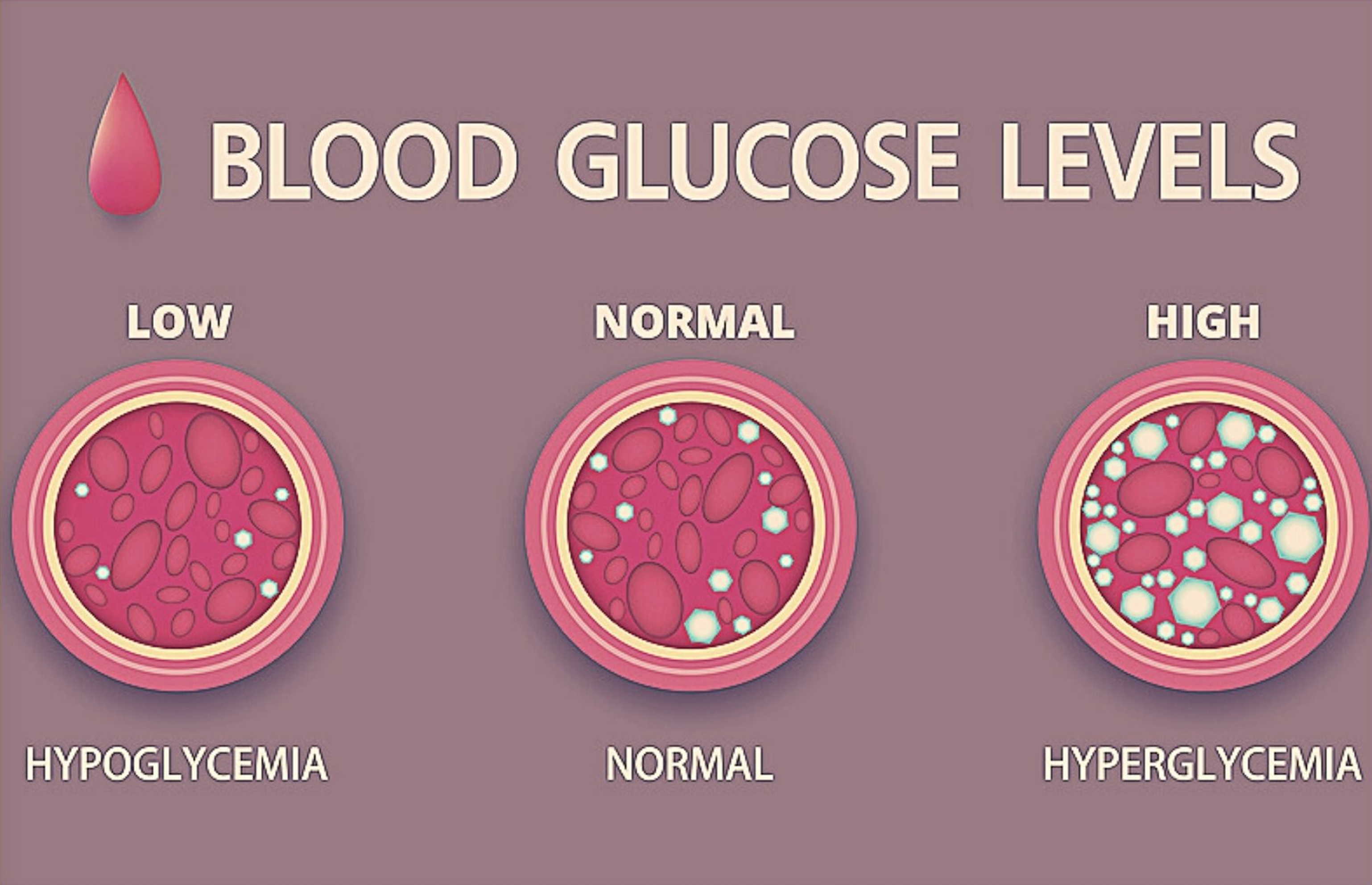A person's blood sugar level is basically the amount of glucose present in their blood at any given time. You might be wondering why anyone would need to know this? Well, keeping your blood sugar balanced is one of the most important factors in maintaining good health - in particular, even energy levels and a healthy weight. Glucose is a simple sugar that is produced by the body from the carbohydrates that we eat. It is necessary for a wide range of critical processes. Most notably, the glucose in your bloodstream is available to your cells to make energy. Glucose is transported from the intestines or liver to cells via the bloodstream, and is made available for cell absorption via insulin (a hormone produced by the pancreas). Glucose that is not directly used as an energy source (for instance, because blood sugar levels are too high) is either:
- sent to the liver, adipose tissue and muscle cells, where it is absorbed and stored as glycogen (our temporary fuel store)
- or converted into fat (our long-term fuel store).
Stored glycogen can be converted back into glucose and returned to the bloodstream whenever insulin is low or absent.
Why are balanced blood sugar levels important?
It is estimated that as many as 3 in every 10 people have an impaired ability to keep their blood sugar levels stable - it may go too high and then drop too low. Blood sugar is normally measured in molecular count (millimoles per litre), or as a weight in grams (milligrams per decilitre). Normally, the body maintains its blood sugar level at a reference range of between 3.6 and 5.8 mmol/L (or 64.8 and 104.4 mg/dL). The normal blood sugar level is around 4 mmol/L (or 72 mg/dL), although it obviously fluctuates throughout the day.
As you might expect, levels tend to be lowest in the morning, before the first meal of the day, and spike for 1 to 2 hours after meals by a few millimolar. However, when it comes to diabetics, blood sugar fluctuates more widely. Over the years, a continual imbalance in blood sugar levels can result in weight gain (if not obesity), increasing feelings of lethargy and possibly more serious health conditions.
Low blood sugar: When blood sugar levels are too low (referred to as hypoglycemia), a host of symptoms can be experienced. These include everything from irritability, nervousness and depression, to fatigue, headaches and digestive problems. In particular, when the level of glucose in your blood drops, you feel hungry. This is how blood sugar can have a direct impact on appetite and weight gain.
High blood sugar: Persistently high blood sugar levels are referred to as hyperglycemia. This can involve a suppressed appetite in the short term, with more serious health problems in the longer term.The bottom line - if you are able to control your blood sugar levels and keep them stable, the result is usually an even weight, healthy body and consistently high energy.
As mentioned above, unstable blood sugar levels over a prolonged period can lead to serious health problems or may be indicative of an underlying medical condition, some of which are described below. Advice should always be sought from a qualified medical practitioner if you have any concerns.
Diabetes is an extreme form of blood sugar imbalance and, possibly, the most well-known - certainly the most common. According to NHS Choices, in England in 2010, there were approximately 3.1 million people aged 16 or over with diabetes (both diagnosed and undiagnosed). By 2030, this figure is expected to rise to 4.6 million, with 90% of those affected having type 2 diabetes. It is a lifelong condition which is characterised by persistent hyperglycemia. Early warning signs are similar to those of mild glucose imbalance, but most notable is a sense of raging thirst.
There are two main types of diabetes - type 1 and type 2. Type 1 usually develops before the age of 40 (often in the teenage years), while type 2 tends to be diagnosed in older people. Type 2 diabetes occurs when the body doesn't produce enough insulin to function properly, or the body's cells don't react to insulin. This is known as insulin resistance (see below). Type 2 diabetes is far more common than type 1 diabetes, which occurs when the body doesn't produce any insulin at all. In the UK, about 90% of all adults with diabetes have type 2. For those with diabetes, it is particularly important to keep blood sugar levels within normal ranges to avoid the development of serious health complications. For instance, kidney disease, nerve disease, eye disease and heart disease.
Insulin resistance is a condition where the body fails to recognise the consumption of sugars and carbohydrates, which means that it continues to pump out insulin which is not needed. If this continues for a prolonged period, the pancreas can shut down and cease to produce insulin altogether. If care is not taken by those who have this condition to ensure a healthy diet and maintain balanced blood sugar levels, it can eventually lead to Type 2 diabetes.
How to keep your blood sugar levels stable.
A wide range of factors can affect a person's blood sugar levels. For example, it can be temporarily elevated as a result of severe stress (such as trauma, surgery or illness), as a result of medication use or through alcohol intake. However, diet, weight and exercise are key.
The most obvious cause of unstable blood sugar levels is eating too much sugar. Arguably, the best way to achieve an optimal balance of blood sugar levels is to control the glycemic load (GL) of your diet. This is widely considered to be a more accurate measure than the glycemic index (GI), as the GL score takes into account both the quality and quantity of the carbohydrate. The GI will only tell you if a food is 'fast' or 'slow' releasing - it won't tell you what the particular carbohydrate will do to your blood sugar or waistline. That's not to say that the GI isn't helpful - it is worth understanding that fast-releasing foods provide a quick burst of energy, which then rapidly burns out - leading to the peaks and troughs which can be so damaging. Prime offenders are sugar and sugary foods, sugary soft drinks, white bread, white pasta, potatoes and white rice. However, the GI can give some misleading results. For example, carrots and chocolates have almost the same GI score, but we all know that carrots are healthier than chocolate. This is because the GI is not taking into account the quantity of carbohydrate - you would have to eat 7 carrots to get the same amount of carbohydrate and the same effect on your weight. The GL score addresses this inconsistency and provides a truer picture.
So, it's not just about what you eat, it is also about the quantity you eat, the quality of the food (i.e. whether natural or processed), how you prepare the food you eat and what you drink. Interestingly, neither fat or protein have any appreciable effect on blood sugar. While they can both be converted into fat, this does not happen in the blood. So, if you are looking for some healthy foods with a good GL score, below are some examples:
- oats
- peas
- beans
- lentils
- berries
- plums
- apples
- pears
- kale
- broccoli
- spinach.
The fibre content of a particular food also lowers the GL, so make a conscious effort to include quality sources of dietary fibre in your diet. When you eat carbohydrate foods with a low GL with quality protein foods, you help to stabilise your blood sugar level even more. As a final tip for keeping those blood sugar levels stable, it is also better to 'graze' throughout the day (eating little and often), than to 'gorge' on large meals. Opt for natural, whole foods - preferably organic and, whenever possible, raw!
Leer más

When people talk about yeast overgrowth in the body, they are referring to harmful yeast organisms. Candidiasis is by far the most common type of yeast infection, and there are more than 20 species...

Everyone knows that oxygen is essential for all life - the body uses it as it breaks down food and creates energy for cells. But did you know that, as well as being an absolute necessity for good h...















Dejar un comentario
Todos los comentarios se revisan antes de su publicación.
Este sitio está protegido por hCaptcha y se aplican la Política de privacidad de hCaptcha y los Términos del servicio.